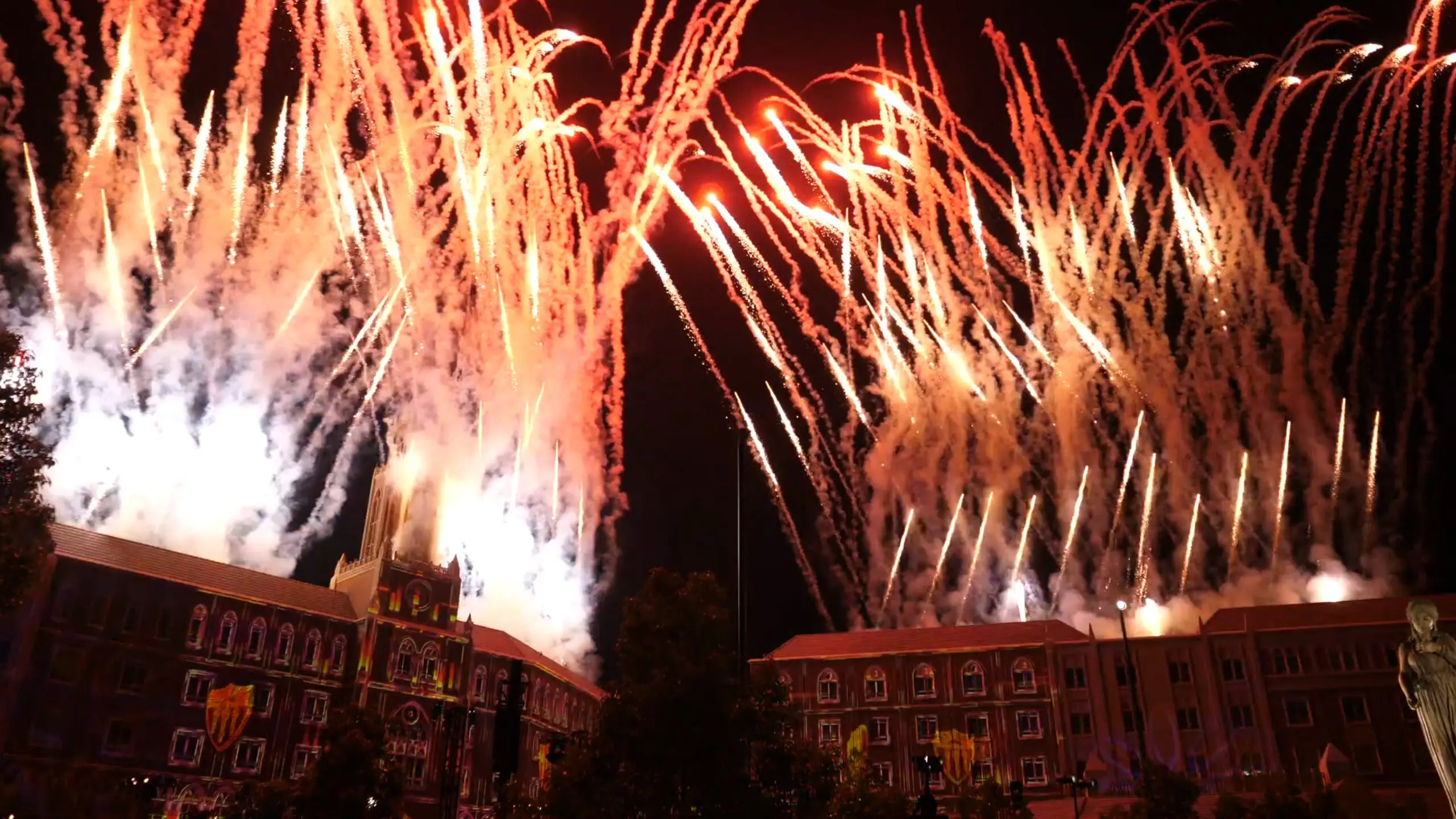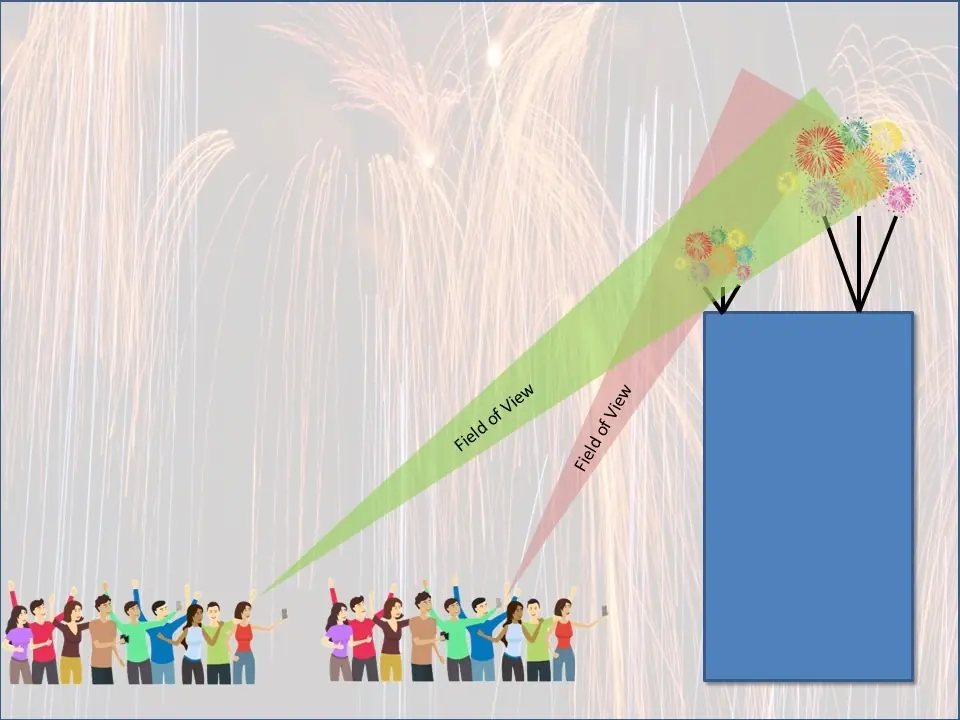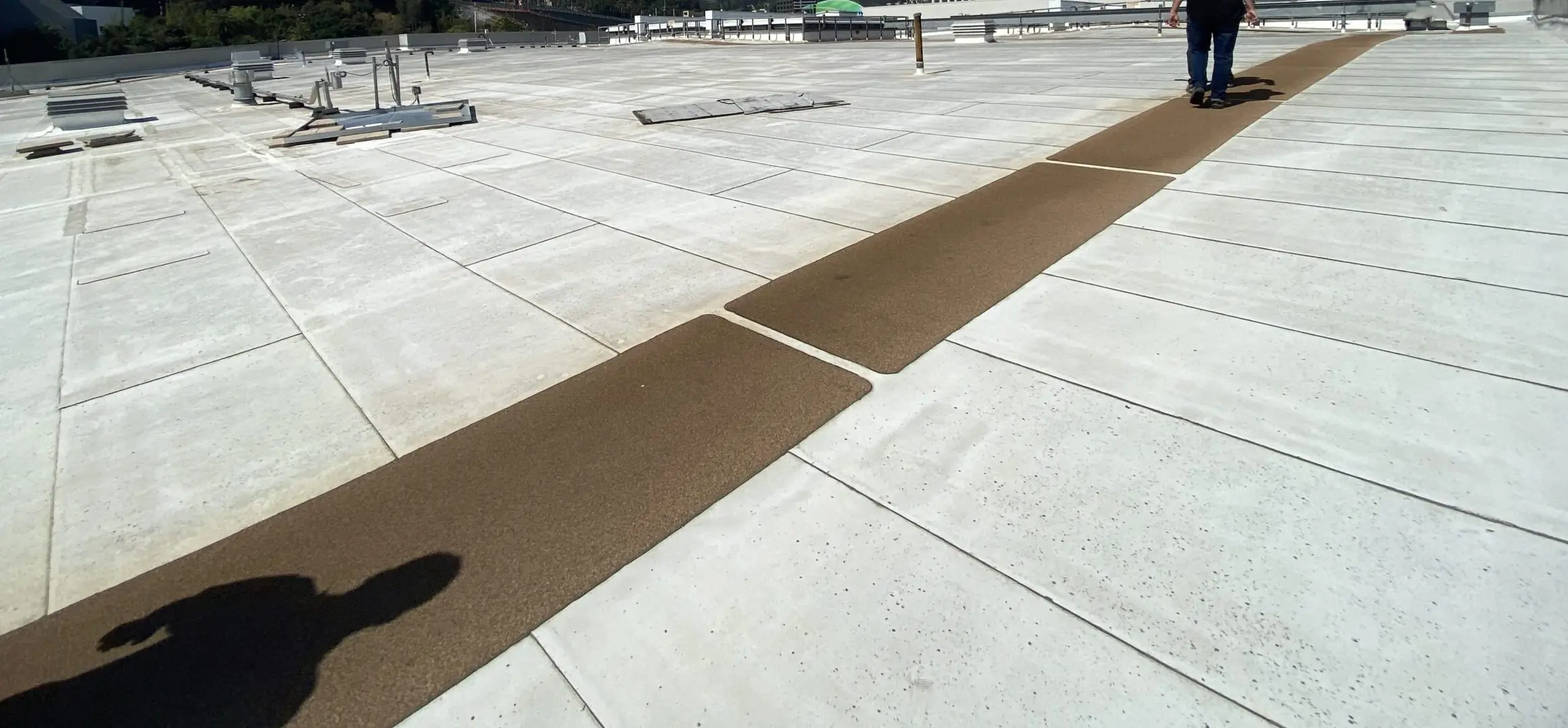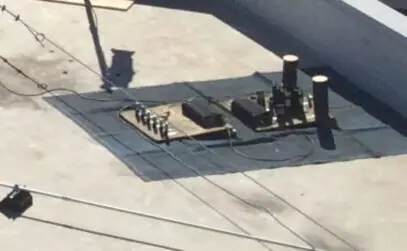Take me back to Advanced Pyrotechnician Training
Rooftop Pyrotechnics
Rooftop pyrotechnic displays pose unique challenges that a pyrotechnician won’t normally encounter at a typical fireworks display. There are special considerations when it comes to safety, logistics, load-in, access, audience locations, and more.

Special Safety Considerations
Fall Hazards
Some roofs have parapet walls that prevent fall hazards, others do not. When a fall hazard is present, clear rules must be communicated to the crew, and fall protection utilized when in proximity to the fall hazards
Fire Suppression
Since you can’t drive a fire truck onto the roof, you must have a plan to address fire suppression such as additional water fire extinguishers, garden hose (if hookups are available), and fire hose (if hydrant is available on the roof). Discuss and agree on the fire suppression plan with your fire inspector.
Drop Hazards
When climbing, lifting, or working at heights, there shouldn’t be anyone below you that is not necessary for the operation. The area below needs to be controlled, and safety gear such as hard hats worn when in the drop hazard zone.
High Power Antennas
Check for antennas during your site inspection and verify with the building owner whether or not they are operational. Under the right conditions, transmitting antennas near your setup can cause ematches to fire, firing system interference (especially if using a wireless system), and human safety issues.
Trip Hazards
Trip hazards such as anchor points and electrical conduits need to be understood and discussed with the crew. These are especially hazardous at night in the dark and even more so if they are close to the edge of the roof.
Emergency Exit
As you would with any show, discuss your emergency exit plan with your crew and fire inspector as it may not be as straight forward as a show on the ground.
Crew / Product / Equipment Access
Access may pose special logistic challenges. Crew access and equipment/product access may be different.
Ladder
If a ladder and / or roof hatch is used for equipment / product access, you will likely have to rope everything up through the hatch or over the side of the building. Must ensure you have proper fall protection, enough rope, and other neccessary rigging. If the ladder is exterior to a building, fall protection may be needed during the climb.
Lift
If there is no elevator and crew access is stairs only, a boom lift may be a good option to get product and equipment on and off of the roof to avoid having to carry everything up many flights of stairs. A lift operation will require a spotter, fall protection, and a controlled area around the lift.
Specialized Gear
Ensure you have all necessary gear to safetly get your setup on and off the roof. This could include rope, cargo nets, carabiners, fall protection, etc.
Physical Conditioning
If carrying everything upstairs or roping everything up through a ladder hatch, the crew being in good physical condition is a must for safety. Do not underestimate the additional physical demand of a rooftop display.

Additional Considerations
Audience Location
Consideration must be given to the audience location relative to how far back on the roof your setup is and the size / caliber of the fireworks you are using. The audience’s field of view will change depending on how close to the building they are. From a safety standpoint, you must consider that you are shooting from an elevated position, so the choice of product (debris-free?) needs to be considered depending on audience location.
Fallout Zone Extends Beyond the Roof
In addition to people, understand what else is within the area around the roof. Other buildings? Trash dumpsters? Must understand everything that will be in your falloutzone below the roof.
Air Intakes
Work with the building owner and fire inspector to understand if any air intakes on the roof could inadvertently draw smoke into the building during the display and have them shut down as appropriate.
Roof Protection
A pyrotechnician must keep burn, abrasion, and puncture prevention as a high priority when firing a display from a roof.
Welding Tarps
Welding Tarps are made of fiberglass and withstand very high temperatures. They are great for burn protection and provide some abrasion resistance as well. For this reason, it is very standard to put welding tarps underneath your setup on roofs, especially membrane types. You may need to secure the tarp edges to prevent wind from blowing them on top of the pyro during the display. Because these tarps are made of fiberglass, you want to ensure anyone handling them has gloves and long sleeves. Using tape to dab (not rub) your clothing or skin after handling works well to remove any fibers. The stickier the tape the better. When striking, do not fold the tarps up with debris inside for the next operator to find.
Mortar Box Ends, Cake Pans, and Cleats
Wooden mortar box ends, wooden cleats, and metal cake pans can also be used underneath the pyrotechnic devices as further burn and abrasion protection.
Pre-Engineering Walking Paths
Some roofs have pre-engineered walking paths, which are typically an additional layer of asphalt roofing material, to minimize wear and tear on the roof, so utilize these paths for walking, equipment, and setup as much as possible.
Nails and Screws
When building props or securing racks, you must be mindful when driving nails or screws. It’s good practice to have another piece of wood between the prop you are working on and the roof to prevent any overpenetration from penetrating the roof itself.
Cleanup
When doing your final cleanup during strike, you need to consider the type of broom or rake being used to sweep up debris. Some roofing materials make it difficult to use either without damaging them. Brooms work best on membrane roofs and if rakes make sense, best to go with ones that have plastic heads, not metal.



Showtime Considerations
Timecode
Do you need timecode run from show control to the roof? Is there a reasonable path to run XLR? Do you have enough XLR? Are you shooting across multiple rooftops of different buildings or roof segments? Should I consider wireless timecode or just a manual count-in?
Firing Location
Choose the location of your firing board in a way that allows for show cues and safety. If you are receiving timecode, location of the XLR run may dictate your controller location. Line of sight to your firing locations is also important to ensure they are clear when you shoot. In the example picture, this vantage point allows for line of sight to the pyro positions on the roof and the stage where visual cues will be given to shoot.
Angles and Roof Obstructions
If you have angled devices or shots, you need to be aware of the muzzle vector such that you don’t hit something on the roof. These obstructions could be a parapet wall, air conditioning unit, or wall to the building, among other things.

